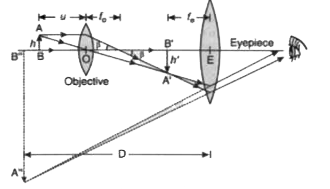(i) Draw a neat labelled ray diagram of a compound microscope. Explain briefly its working.
(ii) Why must both the objective and the eye-piece of a compound microscope have short focal lengths ? Solution in Kannada
(i) 
(ii) The objective forms a real, inverted magnified image of the object. This serves as the object for the second lens, the eyepiece, which functions essentially like a simple microscope or magnifier, produces the final image, which is enlarged and virtual.
To achieve a large magnification of a small object, both the objective and the eyepiece should have small focal lengths.
Topper's Solved these Questions
- RAY OPTICS AND OPTICAL INSTRUMENTSBOOK - OSWAAL PUBLICATIONCHAPTER - RAY OPTICS AND OPTICAL INSTRUMENTSEXERCISE - TOPIC-3(LONG ANSWER TYPE QUESTIONS)
5 Videos
- RAY OPTICS AND OPTICAL INSTRUMENTSBOOK - OSWAAL PUBLICATIONCHAPTER - RAY OPTICS AND OPTICAL INSTRUMENTSEXERCISE - TOPIC-3(Numerical Problems)
3 Videos
- RAY OPTICS AND OPTICAL INSTRUMENTSBOOK - OSWAAL PUBLICATIONCHAPTER - RAY OPTICS AND OPTICAL INSTRUMENTSEXERCISE - TOPIC-3(SHORT ANSWER TYPE QUESTIONS-I)
6 Videos
- NUCLEIBOOK - OSWAAL PUBLICATIONCHAPTER - NUCLEIEXERCISE - TOPIC -2 (Numerical Problems)
3 Videos
- Sample Paper 1BOOK - OSWAAL PUBLICATIONCHAPTER - Sample Paper 1EXERCISE - Exercise
36 Videos
Similar Questions
(a) Draw a neat labelled ray diagram showing the image formation of a distant object by a refracting telescope.
Deduce the expression for its magnifying power when the final image is formed at infinity.
(b) The sum of focal lengths of the two lenses of a refracting telescope is 105 cm. The focal length of one lens is 20 times that of the other. Determine the total magnification of the telescope when the final image is formed at infinity.
View SolutionThe total magnification produced by a compound microscope is 20. The magnification produced by the eye piece is 5. The microscope is focussed on a certain object. The distance between the objective and eyepiece is observed to be 14cm.
If the least distance of distinct vision is 20cm, calculate the focal length of the objective and the eye piece.
View SolutionDraw the ray diagram of image formation in case of compound microscope
View SolutionThe half life of 38Sr90 isotope is 28 years. What is the rate of disintegration of 15 mg of this isotope? (Given Avogadro No =6.023×1023)
View SolutionCharges of 10μC and 15μC are separated by a certain distance. Which charge repels the other with a greater force?
View SolutionDraw a neat labelled diagram of a compound microscope and explain its working. Derive an expression for its magnification.
View Solutiond) Why must both the objective and the eyepiece of a compound microscope have short focal lengths ?
View SolutionWith a neat labelled diagram, explain the construction and working of a compound microscope.
View SolutionThe focal length of objective lens is ______ than the eye pieces in compound microscope.
View SolutionA : The objective and the eye-piece of a compound microscope should have short focal lengths. R : Magnifying power of a compound microscope is inversely proportional to the focal lengths of both the lenses.
View SolutionWhy must both the objective and the eyepiece of a compound microscope have short focal lengths?
View SolutionAnswer the following questions:
(d) Why must both the objective and the eyepiece of a compound microscope have short focal lengths?
View SolutionAnswer the following questions:
(d) Why must both the objective and the eyepiece of a compound microscope have short focal lengths?
View SolutionAnswer the following questions:
(d) Why must both the objective and the eyepiece of a compound microscope have short focal lengths?
View Solutioni) Draw a neat labelled ray diagram of a compound microscope. Explain briefly its working.
(ii) Why must both the objective and the eyepiece of a compound microscope have short focal lengths ?
View Solution